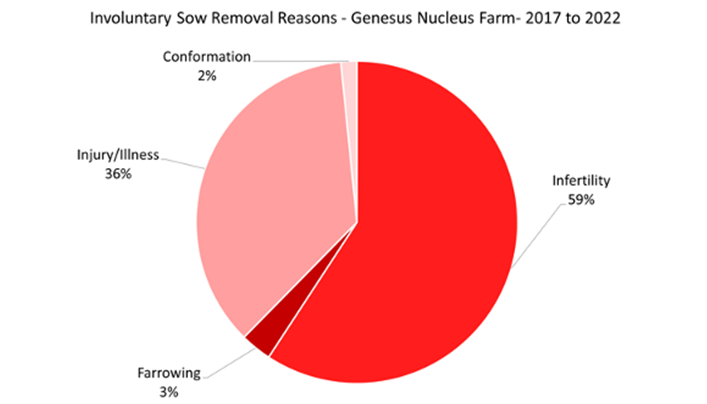



Breeding for sow longevity
A lookinto sow removal and geneticsSow longevity is favorably associated with an increase in both profit and animal welfare. Generally, a sow with increased longevity stays in production longer and produces more piglets in total. However, sow longevity can be looked at in two parts. The first being, increasing the probability that a gilt will achieve parities of maximum productivity and the second being increasing the number of parities (>6) in which a sow is highly productive. By increasing sow longevity, her gilt development cost is spread over more parities, increasing her opportunity to be more profitable. Though premature removal has an unfavorable impact on the profitability and welfare of sows, currently there is no consensus within the scientific community on the optimal way to define and estimate breeding values for longevity. For a commercial sow to be considered profitable, research suggests that she needs to reach a minimum of three parities (Koketsu and Iida, 2020; Poulsen et al. 2020). However, at any given time many of the sows in a herd have not had the opportunity to reach 3rd parity and thus the optimal way to estimate the total number of parties a sow may be in the herd for is still arguably undefined.
Reasons for sow removal can be both voluntary and involuntary. Voluntary removal is when the producer decides to remove the sow from the herd for reasons such as age, parity, temperament, etc. Involuntary removal is when a producer is forced to remove a productive animal for reasons such as lameness, illness, injury, infertility, or death. That said, management decisions and consistent removal reasons are difficult to standardize across farms, which can lead to challenges in defining the phenotype. Additionally, longevity traits are challenging to independently identify and define, as they are phenotypically and genetically correlated to other traits such as conformation (body and leg structure), number of piglets born alive, body condition and litter weaning weight.
Sow longevity is generally heritable (how much of the differences between pigs is attributed to their DNA), however estimates vary across populations and on the specific definition of longevity. Currently heritability estimates are thought to range from 0.04 to 0.25 (Plaengkaeo et al. 2021), meaning that the trait will generally respond to selection. That said, the longevity phenotype isn’t known until a sow has been culled or has died. This is especially important in nucleus herds where selection is performed because most sows are removed for genetic improvement reasons before they can express longevity phenotypes. Thus, other sources of information are required to allow for accurate breeding value estimates and selection at the nucleus level. These potential sources of information include commercial and multiplier herd data, genomic information and indicator traits that are measured early in life and are highly genetically correlated with longevity.
Understanding why sows are leaving the herd can help narrow the focus on which indicator traits should be focused on. Voluntary removal reasons are useful for knowing things such as the maximum age or parity that the producer uses to remove sows. Involuntary removal reasons are very informative because they generally indicate failure on the part of the sow to reach a predefined standard. To better understand reasons why sows are prematurely culled, a subset of sow removal reasons was captured within two Genesus maternal nucleus units and one commercial unit to help identify the distribution of voluntary vs involuntary removal.


Figure 1: Involuntary sow removal reasons from 2017 to 2022 for two Genesus maternal nucleus herds and a Genesus F1 commercial farm
As shown in Figures 1 and 2, it is clear the largest areas related to involuntary removal are challenges with infertility, injury, or illness. While these areas are large and can encompass many things, it is an important first step in identifying areas to focus genetic selection to improve longevity. It is also worth noting that differences are observed between the nucleus herds and the commercial herd. This variation in removal reasons is expected when considering different herds and populations. Additionally, this variation also highlights the importance of considering data from various sources to obtain an accurate picture of involuntary sow removal reason, allowing for an accurate development of a sow longevity trait.
Planned future work includes identifying indicator traits to include with sow removal to develop an accurate sow longevity genomic estimated breeding value. This work is aimed at providing the most profitable maternal genetics through the incorporation of longevity into the Genesus breeding program, ultimately benefiting Genesus customers.
References:
Koketsu Y. and Iida R. (2020). Porc. Health Manag. 6(24): 1-12. https://doi.org/10.1186/s40813-020-00163-1
Plaengkaeo S., Duangjinda M., and Stalder K.J., (2021). Anim Biosci. 34(1): 20-25. https://doi.org/10.5713/ajas.19.0855
Poulsen B.G., Nielsen B., Ostersen T., and Christensen O.F. (2020). J. Anim. Sci. 98(6):1-8. https://doi.org/10.1093/jas/skaa183






